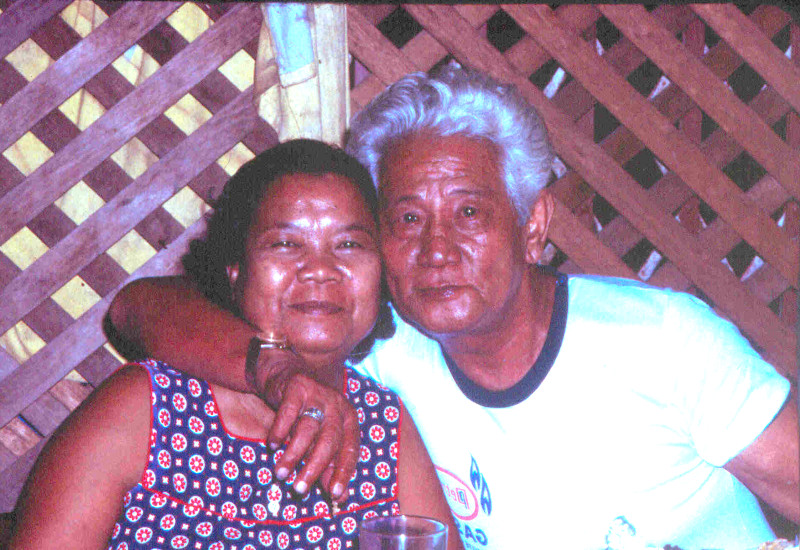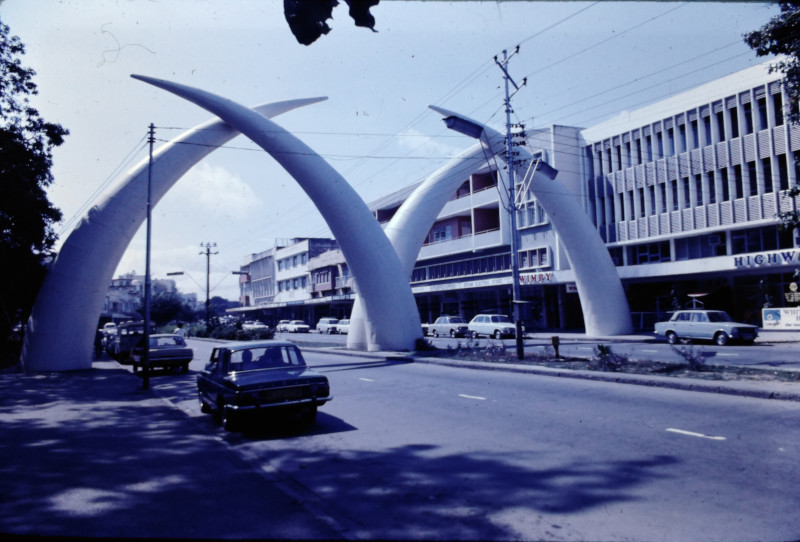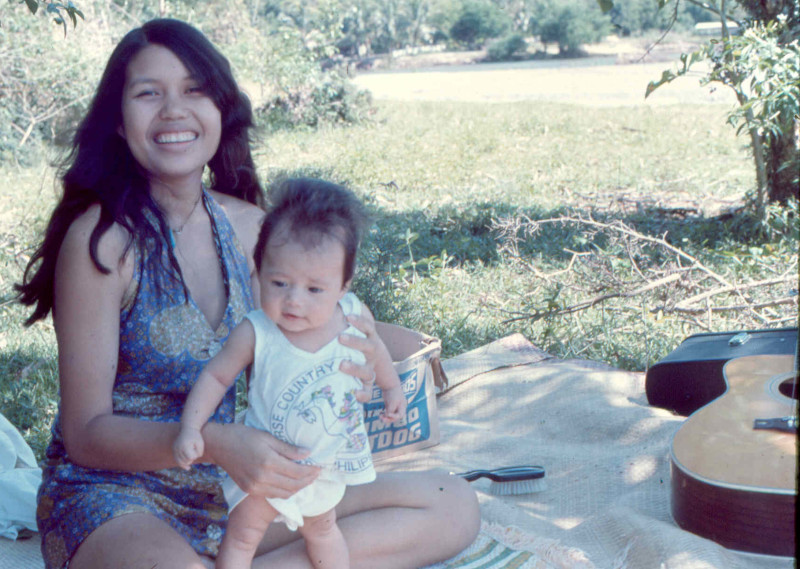Life after the Vietnam War

From April 1973 until I transferred to Clark Air Force base in November 1974 my personal quality of life had increased dramatically. With more time at my home duty station and less time at sea, I moved in my friend and good shipmate Ted Finch in an apartment behind my favorite bar, Teresa’s Upscoop. I made friends with the landlord and landlady, kuya Burting Almario and his wife Ate Elly (whom I called papasan and mamasan) who acted as my surrogate parents. I enjoyed many lunches with them and kuya Bert’s evening gatherings at the “White Castle” table for whiskey and pulutan (snacks). It was great company, great conversations, and for me a great deal of learning Philippine culture. I still had a lot of sea time between April 1973 and November 1974, about 222 days worth (see Chapter 1) but I had much longer breaks in between.
My deployment record after the U.S. pulled combat troops out of Vietnam is as follows:
- USS Constellation (CVA-64) (COMCARGRU Five) 7 June 1973 – 13 June 1973
- USS Coral Sea (CVA-43) 13 June 1973 – 24 Jun 1973
- USS Hancock (CVA-19) (COMCARGRU Three) 24 June 1973 – 5 July 1973
- USS Constellation (CVA-64) (COMCARGRU Five) 5 July 1973 – 27 Aug 1973
- USS Coral Sea (COMCARGRU Three) 6 October 1973 – 21 October 1973
- USS Hancock (COMCARGRU Seven) 21 October 1973 – 17 December 1973
- USS Kitty Hawk (CV-63) 21 February 1974 – 1 May 1974
The Constellation and Coral Sea (June 1973) operated in the South China Sea just to let North Vietnam know we were still around. The USS Hancock however was called into the Indian Ocean in October 1973 in reaction to the Yom Kippur War15 and the Soviet Union’s build-up in the Mediterranean Sea16. We spent many long days doing donuts in the waters of the Gulf of Aden and our team was unable to provide any real mission support to the operation due to the lack of technical materials and unfamiliarity with the region. Our Aircraft were grounded for a couple of weeks when a dust storm blew in sending a cloud of very fine dust 150 miles out to sea. It settled like a thick coating of flower on everything inside the ship so we tied wet sheets around the air intakes to try to control it which helped very little. After nearly 3 months we finally headed back to the Philippines and I threw my Hancock coffee mug into the Gulf of Aden as we departed in a token gesture of my disdain for the place. That was my second Indian Ocean deployment and both were total busts as far as mission support or liberty calls.

My last deployment from San Miguel was aboard the USS Kitty Hawk from February to May 1974. She also deployed to the Indian Ocean but the trip was planned before leaving Subic so we were somewhat more prepared17. There were 2 highlights on this trip. First we were overflown by a Soviet KA-25 Hormone helicopter off a Soviet cruiser. It was a very short flight for the Hormone so we had little time to react. The carrier tried to scramble the SH-3 Sea King helicopter to escort the Hormone and buffer it away from the carrier, but when the Hormone got very close the crew of the SH-3 jumped out on deck and began taking pictures of it. The Hormone was able to fly right over our deck and could have done us in by throwing a cigarette butt on the flight deck. The Commanding Officer was understandably pissed off while the air boss screamed at the crew over the loud speakers. The Hormone crew were probably laughing their asses off. As the say goes: Some days you get the bear and some days the bear gets you. Secondly we were given liberty in port Mombasa, Kenya. It was my first visit to this city. Many of the crew were able to take leave and go on safari trips coordinated by our Moral Welfare and Recreation department. I unfortunately was unable to go on leave due to duties aboard the ship even while in port. This was my third Indian Ocean deployment and it was turning out to be the area of responsibility (AOR) for our direct support missions and we were becoming more proficient all the time.

I met Tessie who was visiting San Miguel from her aunt’s place in Olongapo City and I almost immediately moved her into our apartment. She was much taller than all the other women in the Philippines and had a unique accent from her home province in Campoyong, Guiuan, Easter Samar that I loved. She was sweet, shy, kind and extremely beautiful. Her Philippine ID said she was 23, easy to get fake ID back then, but I assumed she was around 19. Turns out she had just turned 16 but her life experiences made her much more mature for her age. That’s another story altogether. I didn’t appreciate her as much as I should have at the time but Tess soon became the reason behind most of my decisions, a guiding light, and she remains so to this day.

With my shore duty, in addition to setting up house with Tess, I bought a used Honda 100 motorcycle to get around on. Because our mission had dwindled to nearly nothing, I was farmed out to work for RM1 Bob Stanton as a U.S. Customs Inspector. My junior military grade was irrelevant to my duties as a U.S. Customs Inspector so we wore civilian clothes to all the sites we worked. Our job was to ensure that the sailors packing out for transfer elsewhere were not trying to include anything considered contraband or illegal was put into their household goods shipments. I got to job sites on that little Honda carrying a briefcase balanced on the fuel tank and between my legs and it was the rainy season to boot. I never had a run-in with anybody nor did I ever have to confiscate anything of great value. I did let on chief petty officer pack an ivory chess set he had purchased before the ban on ivory as he was going to Misawa, Japan, not the United States. I’d let the next inspector worry about confiscating it. In June 1974, our daughter Maria was born in the apartment behind Teresa’s Upscoop that I now occupied by myself after Ted had transferred back to the States.
The Navy had decided to close down our Direct Support mission entirely at San Miguel and move it to the Naval Security Group Detachment at Clark Air Force Base, Philippines. I was due for separation in July so I finagled orders to Clark in return for re-enlisting for another 4 years. I wanted to get married to Tess but if I had put in my request at San Miguel they would have immediately taken my security clearance and shipped me out of San Miguel on the first ship leaving Subic Naval Base. I had seen it happen to several sailors before me. It was a crazy policy using security fearing these girls might have ties to the Philippine Communist Party as a cover for blatant prejudice against Filipinos. Our station in Taiwan (Republic of China) had been granting marriage request for some time and I’m sure some of those ladies had communist relative in the Peoples Republic of China. Clark on the other hand held promise of keeping me and my security clearance while they investigated Tess’ background. In November I took 30 days leave and went home for the first time since after boot camp. I was glad to see my family and I was able to explain my marriage situation to my mother. Otherwise, America in the post Vietnam era seemed pretty dull. I was glad I had re-enlisted and was looking forward to getting back to my new family in the Philippines.
Operation Frequent Wind
Operation Eagle Pull
WASHINGTON, Oct. 29 —The United States moved a naval task force, including an aircraft carrier, toward the Indian Ocean today in what the Defense Department first suggested was a response to Soviet naval build‐up in the Mediterranean, but then insisted was a periodic demonstration of sea power.
The Pentagon announced that the attack carrier Hancock, accompanied by five destroyers and a tanker, was moving today through the Strait of Malacca, which separates Sumatra and the Malay peninsula.
The force was scheduled to be in the Indian Ocean within a day.
1973 Yom Kippur War https://www.history.com/articles/yom-kippur-war
